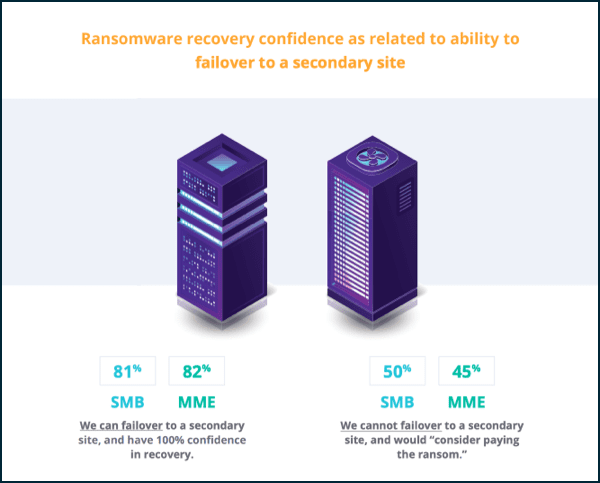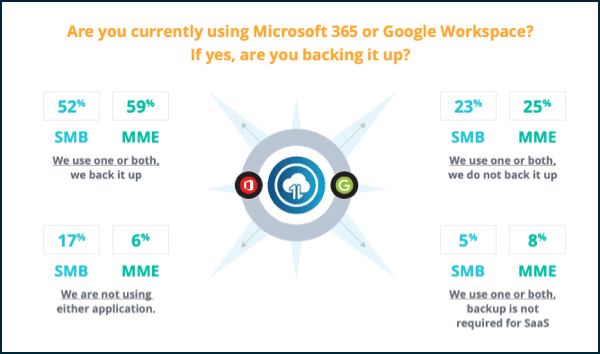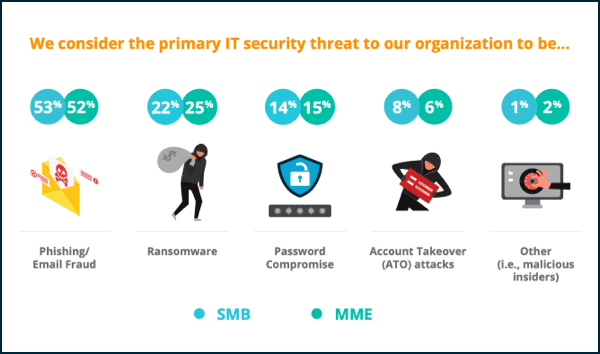Backup
Cloud and Data Security
Cybersecurity
IndustryTech Trends and Insights 2022 Survey: Tech Trends Impacting SMBs and MMEs in 2022
Tech Trends and Insights 2022 Survey Report highlights technology-related priorities and concerns of worldwide IT professionals in response to hybrid work.
By
Spanning Cloud Apps
5 minute read
Tech Trends and Insights 2022 Survey Report sheds light on the transition to hybrid work culture in today’s digital economy. It provides insights into the technology-related priorities and concerns of worldwide IT professionals and how they have adapted their approaches toward remote monitoring and management, application delivery, security, and data backup and disaster recovery in this evolving landscape.
The COVID-19 pandemic has upended the work culture once and for all. We were disrupted at first, then we adjusted and improvised and now we are in the new normal, where the work culture is agile and hybrid. Most organizations — from startups to MNCs — have implemented some form of hybrid working arrangement. Studies suggest that it’s indeed the future of work and organizations ready to embrace it are conferred many competitive advantages. However, this transition also brings with it many disruptions and challenges.
This survey analyses the state of preparedness of small and midsize businesses (SMBs; <1,000 employees) and mid-market enterprise (MME; >1,001 employees) organizations on various aspects with respect to this transition. Respondents from SMBs account for 56.14% of our survey data, with MME organizations accounting for 43.86%. The survey has also ensured strong representation across different industry verticals and regions, including the Americas, EMEA and APAC (Asia-Pacific).
Let’s look at some of the major highlights of the Tech Trends and Insights 2022 Survey Report. Get the full report for more details.
Top IT priorities
Organizations jumped at the opportunity to leverage hybrid environments to maintain business continuity during the pandemic. This seismic shift to a hybrid business model introduced new workloads, both remote and in the cloud. Consequently, businesses have increasingly leveraged leading-edge digital solutions like SaaS applications to foster collaboration and scalability. Unfortunately, these solutions have introduced new threat vectors and galvanized some others that had fallen out of prominence.
Survey respondents indicated a heightened emphasis on ensuring the security of these platforms and the users within them.
- Phishing awareness: More than 1/3 of all respondents cited “phishing awareness” as their top priority for 2022. Involved in more than 40% of all cybersecurity incidents, phishing and social engineering remain one of the most prominent attack vectors today.
- Data privacy and protection: 21% of SMBs and 29% of MME organizations cited data privacy and protection as their top priority.
| Top Priority | SMB | MME |
|---|
| Phishing Awareness | 37% | 36% |
| Security Best Practices (e.g., password protection) | 27% | 19% |
| Data Privacy & Protection | 21% | 29% |
| Compliance | 14% | 15% |
Top SaaS applications driving modern business
The transition to hybrid work culture also characterized the growth of SaaS from an emerging technology to a ubiquitous one. SaaS applications have become a cornerstone for modern businesses, offering unprecedented speed, scalability and cost-effectiveness. Better Cloud projects that 85% of software used by organizations will be SaaS by 2025.
While SaaS applications offer tremendous value to organizations, they can be a double-edged sword. As the volume of data stored in SaaS applications like Microsoft 365 and Google Workspace grows, it introduces increased cyber-risks to a business. Organizations need to understand that while the SaaS platforms themselves are highly unlikely potential victims of ransomware attacks and difficult to penetrate, the data stored in them can be a relatively easy target. The data in them can be attacked through end-user phishing, malware or other malicious ways.
 According to our survey, nearly half of the respondents who do not have the capability to failover to a secondary site in the wake of a ransomware attack cited they would consider paying the ransom.
According to our survey, nearly half of the respondents who do not have the capability to failover to a secondary site in the wake of a ransomware attack cited they would consider paying the ransom.
Why backup SaaS apps?
SaaS platforms do offer flexibility, reliability and scalability, but it doesn’t equate to data security. Many organizations mistakenly believe their SaaS provider is responsible for protecting their company’s data. In fact, SaaS providers have a “shared responsibility model” for data — while they ensure the security and integrity of the platform, the onus falls on their customers to manage and secure the data generated.
As per the 2021 Data Protection Cloud Strategies report, 35% of organizations surveyed solely rely on SaaS vendors to protect their data. SaaS vendors like Microsoft, Google and Salesforce operate data centers with state-of-the-art disaster recovery capabilities to protect from infrastructure threats like hardware and software failure, power outages and natural disasters. However, they cannot protect your data from the most common causes of cloud data loss.
 Among the survey respondents utilizing Microsoft 365 and/or Google Workspace, 64% of SMBs and 63% of MMEs report backing up their SaaS data.
Among the survey respondents utilizing Microsoft 365 and/or Google Workspace, 64% of SMBs and 63% of MMEs report backing up their SaaS data.
Top IT security threat
The hybrid work culture and the ensuing rapid digital transformation have opened a pandora’s box of cybersecurity risks for SMBs and MMEs alike. According to the Identity Theft Resource Center, approximately 92% of the data breaches in the first quarter of 2022 resulted from cyberattacks. As the companies’ digital footprint burgeons, IT security and risk management teams are walking a tightrope.
 According to our survey respondents, phishing has remained one of the most prominent attack vectors over the last year. 53% SMBs and 52% MMEs consider it the primary IT security threat. Ransomware also remains a major threat for organizations, with 22% SMBs and 25% MMEs citing it as their immediate IT security threat.
According to our survey respondents, phishing has remained one of the most prominent attack vectors over the last year. 53% SMBs and 52% MMEs consider it the primary IT security threat. Ransomware also remains a major threat for organizations, with 22% SMBs and 25% MMEs citing it as their immediate IT security threat.
Spanning Backup: comprehensive protection to your SaaS data
Data loss by human error, insider threat or cyberattack can devastate an organization’s business continuity. Having a cost-effective backup and recovery solution that enables you to back up all your SaaS data is a serious consideration for your business. On that front, Spanning Backup is a purpose-built, cloud-native backup and recovery solution for Microsoft 365, Google Workspace and Salesforce. It is a plug-and-play solution that makes SaaS data backup seamless and ensures your business data stays available, compliant and secure all the time.
Spanning Backup can indeed play a critical role in the business continuity and disaster recovery (BCDR) strategy of your organization. It helps you recover business-critical SaaS data accurately and swiftly within minutes. The set-and-forget system also saves countless hours of manual work and money.
For more details on the Tech Trends and Insights 2022 Survey Report, download your free copy of the full report.
Download the Report